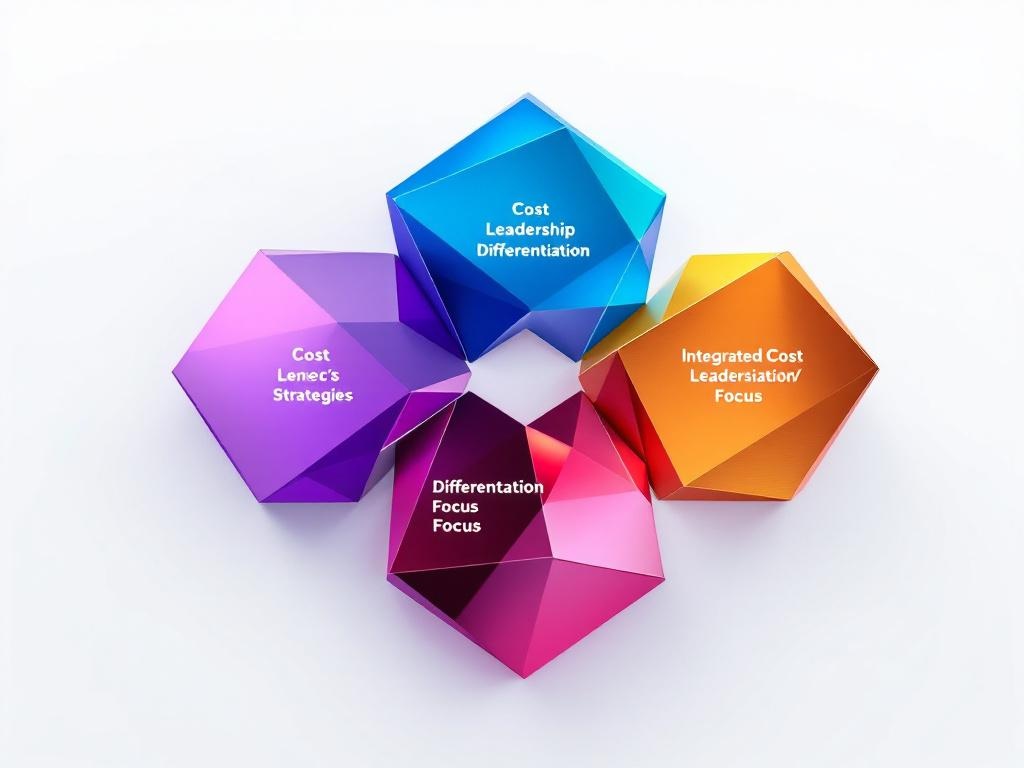
Michael Porter’s Five Generic Strategies
Michael Porter’s Five Generic Strategies provide a framework of five key approaches—Cost Leadership, Differentiation, Cost Focus, Differentiation Focus, and Integrated Cost Leadership/Differentiation. Organizations implement these strategies to gain competitive advantage. They’re the foundation of strategic positioning, helping companies establish defendable market positions through deliberate choices about customer value delivery.
Why Businesses Need Porter’s Five Generic Strategies
Michael Porter’s Five Generic Strategies help companies create sustainable competitive advantage in crowded markets. These frameworks allow businesses to make coherent strategic choices instead of pursuing conflicting objectives that weaken their market position. By choosing and implementing the right strategy, you can align your resources, capabilities, and activities to create unique value propositions that competitors struggle to copy.
The strategies give leadership teams clear direction for decision-making across operations, marketing, innovation, and talent management. This ensures that tactical choices support the competitive position your company wants to establish. Strategic positioning becomes more effective when guided by Porter’s structured approach to competitive advantage. Strategic positioning plays an essential role in achieving long-term success.
Companies that successfully implement one of Porter’s generic strategies achieve higher performance than those that fail to select the right strategy, often due to clearer market positioning and resource alignment.
“`html
Discover Michael Porter’s Five Generic Strategies: Unlock Your Competitive Advantage
Understanding Michael Porter’s five generic strategies is crucial for any business looking to establish a competitive edge in today’s market. Each of these strategies—Cost Leadership, Differentiation, Cost Focus, Differentiation Focus, and Integrated Cost Leadership/Differentiation—provides unique pathways for organizations to optimize their operational effectiveness and cater to various customer needs. In the following sections, we will explore each strategy in depth, revealing key elements and real-world examples that illustrate successful implementation. Whether your business aims to achieve cost efficiency or foster brand loyalty through differentiation, this guide will equip you with the insights needed to navigate your strategic options effectively. Read on to discover how these foundational strategies can propel your organization toward sustainable success.
“`
“`html
1. Cost Leadership Strategy
When implementing Michael Porter’s five generic strategies, cost leadership positions your company as the lowest-cost producer in your industry. This approach creates a defendable position against competitors and powerful buyers by establishing price advantages that are difficult to match. To successfully execute this strategy, you need several key elements including economies of scale, proprietary technology, and preferential access to resources. Companies like Walmart, IKEA, and McDonald’s have mastered this strategy through cost leadership techniques that focus on rigorous cost control. The implementation involves minimizing overhead expenses, streamlining operations, and constantly seeking efficiency improvements throughout the value chain. This strategy works particularly well in markets where price sensitivity is high and product differentiation is low.
“`
2. Differentiation Strategy
When implementing Michael Porter’s five generic strategies, the differentiation strategy stands out as a powerful approach for creating market advantage. This strategy involves developing products and services with unique attributes that customers perceive as valuable and different from competitors’ offerings.
The significance of differentiation in Porter’s strategic framework cannot be overstated. By creating distinctive value, you can command premium pricing while building strong brand loyalty that insulates your business from competitive pressures. Customers become less price-sensitive when they believe your offering provides superior benefits.
Key elements of a successful differentiation strategy include:
- Superior quality that exceeds industry standards
- Innovative features that solve customer problems in novel ways
- Exceptional service that creates memorable experiences
- Brand prestige that conveys status or exclusivity
- Technological advantages that competitors cannot easily replicate
Companies like Apple, Tesla, and Starbucks have mastered competitive differentiation strategies by investing heavily in their unique value propositions. Apple’s seamless ecosystem, Tesla’s electric vehicle innovation, and Starbucks’ distinctive coffee experience all command price premiums.
Implementation typically requires substantial investment in research and development, sophisticated brand building initiatives, and creating extraordinary customer experiences. These investments, while costly, create barriers to imitation and strengthen your market position through Michael Porter’s five generic strategies framework.
Expert Insight: To successfully implement a differentiation strategy, invest in superior quality, innovative features, and exceptional service that resonate with customers. Building brand prestige and technological advantages can create unique value propositions. Ultimately, these efforts lead to premium pricing and strong customer loyalty, fortifying your market position against competitors.
3. Cost Focus Strategy
Within Michael Porter’s five generic strategies, the Cost Focus Strategy targets cost leadership in specific market segments rather than the entire industry. This approach allows businesses to serve niche markets more efficiently than broad-market competitors. By concentrating resources on particular customer segments, companies implement specialized production processes and streamlined offerings tailored to their target audience.
Spirit Airlines exemplifies this strategy by offering bare-bones air travel at rock-bottom prices to budget-conscious travelers. Similarly, grocery retailers Aldi and Trader Joe’s maintain limited inventory and private-label products to keep costs minimal while serving specific customer preferences.
To implement a cost focus strategy effectively, you need to:
- Identify underserved market segments with price sensitivity
- Design streamlined operations specific to these segments
- Eliminate features unnecessary to target customers
- Develop specialized production processes
- Create efficient distribution channels
The key advantage lies in your ability to develop targeted solutions that larger competitors cannot match in both price and segment fit. However, success depends on maintaining sufficient market size and protecting against broader competitors who might target your niche.
Expert Insight: To effectively implement a Cost Focus Strategy, identify underserved, price-sensitive market segments and design tailored operations that eliminate unnecessary features. Streamline production and distribution channels to maintain cost leadership, allowing your business to deliver targeted solutions that larger competitors struggle to match. Safeguard your niche against broader competition.
4. Differentiation Focus Strategy
The differentiation focus strategy is a key approach within Michael Porter’s five generic strategies that enables businesses to target specific market segments with unique offerings. This strategy combines the precision of focus with the premium appeal of differentiation. By developing specialized products for a narrow customer base, you create exceptional value that broader competitors cannot match.
When implementing this strategy, your business concentrates on deeply understanding a particular segment’s needs and preferences. Companies like Rolex and Ferrari exemplify this approach by developing distinctive competitive advantages through exclusive features and specialized expertise. These brands command premium prices because their target customers value uniqueness over cost savings.
The key elements for success include:
- Customized offerings tailored to specific customer requirements
- Specialized knowledge that mainstream competitors lack
- Exclusive product features or service components
- Strong brand positioning within the niche
This approach creates powerful customer loyalty as buyers develop strong attachments to brands that perfectly address their specialized needs. The strategic planning process for this approach requires constant innovation within your chosen niche to maintain differentiation as competitors attempt to enter your space.
Expert Insight: To successfully implement a differentiation focus strategy, deeply understand your target segment’s unique needs and preferences. Offer customized products with exclusive features that mainstream competitors lack, fostering strong brand loyalty. Continuously innovate within your niche to maintain your competitive edge and distinction in the market.
5. Integrated Cost Leadership/Differentiation Strategy
The integrated cost leadership/differentiation strategy represents one of Michael Porter’s five generic strategies that combines two fundamental approaches. When implementing this hybrid strategy, companies simultaneously pursue low costs while offering meaningful differentiation to customers. This balanced approach provides significant flexibility in responding to competitive pressures.
Organizations using this strategy develop innovative business models that deliver unique value while maintaining cost efficiency. Toyota exemplifies this approach by producing reliable, fuel-efficient vehicles with competitive pricing through their lean manufacturing system. Similarly, Amazon offers vast selection and convenience while maintaining aggressive pricing through operational excellence and strategic planning techniques.
The key elements that make this strategy successful include:
- Advanced technology implementation that reduces costs while enhancing offerings
- Strategic partnerships that strengthen competitive positioning
- Innovative operational models that balance efficiency with differentiation
- Continuous improvement processes that refine both cost structure and unique value
Companies implementing this strategy often leverage technology for operational efficiency while strategically investing in key differentiating features that customers value most. This requires careful project portfolio management to balance resources between cost-saving initiatives and value-enhancing investments.
Expert Insight: To successfully implement an integrated cost leadership/differentiation strategy, focus on leveraging advanced technology for efficiency while strategically investing in unique value features. Foster strategic partnerships and engage in continuous improvement to balance cost-saving initiatives with differentiation. This ensures adaptability in the face of competitive pressures while delivering customer value.
Michael Porter’s Five Generic Strategies
Michael Porter’s five generic strategies provide a framework for organizations to create sustainable competitive advantage through distinct strategic approaches. These strategies—cost leadership, differentiation, cost focus, differentiation focus, and integrated cost leadership/differentiation—offer businesses tactical pathways to position themselves advantageously against competitors by leveraging specific organizational strengths.
Importance of Five Generic Strategies
Michael Porter’s five generic strategies are essential for business leaders seeking to establish defendable market positions in increasingly competitive environments. By implementing these strategic approaches, enterprises can create clear competitive advantages through either cost efficiency or value differentiation.
- Cost Efficiency: Allowing organizations to weather market pressures.
- Value Differentiation: Enabling businesses to command optimal pricing.
Additionally, these strategies help build customer loyalty while creating barriers to entry that protect market share from competitors and new entrants.






